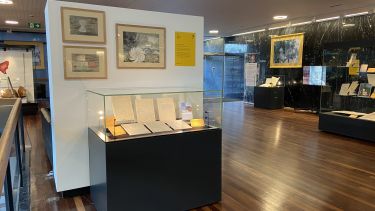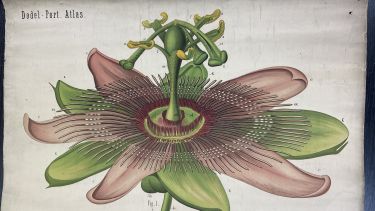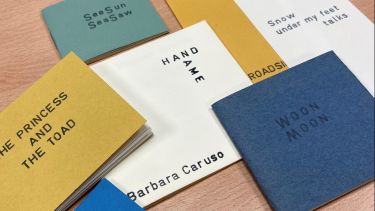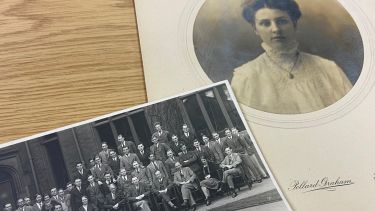Irene Champernowne (1901-76)
Irene Champernowne was a leading psychotherapist in the UK, who pioneered the integrating power of creativeness to improve mental health and whose vision was to make psychotherapy available to all. Influenced by Carl Jung’s psychoanalytic theories, Champernowne pioneered art therapy as a source of treatment which is still used in today’s therapeutic practices.
The collection was recently donated to The University of Sheffield Special Collections and Archives by the Champernowne Trust and will be available to search online in the future.
Irene was born in London in 1901 and grew up in a religious household, and she kept a deep faith throughout her life. She studied at Birkbeck, University of London, however by 1925 the stress of her studies alongside working to financially support herself led to significant mental turmoil. She spent the year after graduation recovering on a farm with friends, but remained haunted by an early formative experience in her life. Her cousin had had a breakdown after returning from fighting in the First World War and was hospitalised for the rest of his life. As an adolescent she considered becoming "a mental doctor" as "this might redeem [her] cousin's endless pain". Whilst recovering from her depression at the farm she went for her first analysis, and this proved to be the first step in her career working to improve mental health.
During this time Irene met her husband Gilbert Champernowne, and they went on to found the Withymead Centre together in 1942. The centre was the first therapeutic community in Great Britain to be based on Jungian principles and promoted psychological healing through the arts and psychotherapy. It was based at a large Georgian house with outbuildings and stables, near Exeter. 240 fee-paying adults attended the centre between 1942 and 1954, taking part in a range of art therapy activities, such as drama, movement, music, art and pottery, in conjunction with psychotherapy. The facilities and classes encouraged the creative development of the staff and residents that made up the Withymead community.
In creating and managing Withymead, Champernowne proved herself a pioneering leader, showing strength and determination to enact her vision. Gilbert died in November 1959, and following financial struggles, pressure from new NHS regulations and internal conflicts, the Withymead Centre closed in 1967.
After the closure of Withymead Irene continued to develop psychotherapy through the arts, delivering lectures and courses, from her home in the Cotswolds. Patients would travel there for analysis with her, and she went on seeing patients up to the week before she died in 1976 aged 75, having been diagnosed with inoperable cancer 18 months before.
A new exhibition about Irene launched in the Western Bank Library in January and is on until June 2023, titled ‘The Power of Creativeness: Champernowne, Withymead and Jung’, telling the story of her journey, the stories of the communities and the people who supported and influenced her, and the ongoing legacy of her work through current and new creativity.
Elizabeth Firth (1797-1837)
Elizabeth was born in 1797, the daughter of Dr John Scholefield Firth, a wealthy physician, and his wife, Elizabeth. We have 18 diaries written by Elizabeth in the collection, and they give an insight into the day-to-day life of a young woman living in Yorkshire in the first half of the nineteenth century.
The diaries begin in 1812 when Elizabeth is fifteen years old, spending Christmas with her parents at her home Kipping House, in Thornton. Elizabeth returned to boarding school at Crofton Hall near Wakefield, Yorkshire in March 1812. The headmistress at the time was Richmal Mangnall, who’s Historical and Miscellaneous Questions for the Use of Young People became a very influential and widely used method of teaching for the next century after publication in 1798. This book, giving concise questions and answers to be learned by heart on a wide range of topics, was in regular use at the school when Elizabeth attended. School reports in the collection written by Mangnall, dating from 1811 and 1813, record Elizabeth’s excellent performance in repeating the English and History questions.
The Brontë family arrived in Thornton in 1815 when Elizabeth was eighteen years old, as Patrick Brontë was appointed curate there. The diaries contain regular mentions of the Brontë family, and Elizabeth seems to have been closely acquainted with them for a number of years, even becoming godmother to one of the children.
There appears to have been a break between them in 1821. Elizabeth’s father had died at the end of 1820, and Elizabeth had then helped the Brontë family during Mrs Brontë’s illness and death in 1821. It has been suggested that Mr Brontë made a proposal of marriage to Elizabeth in December, only three months after his wife's death, and whilst Elizabeth would have still been in mourning for her own father. No record survives of any direct mention of the proposal, however after a visit to Kipping House by Mr Brontë on 8-10 December, Elizabeth writes two days later 'A Letter from Mr Bronte', then she records on 14 December 'I wrote my last letter to Mr Brontë', with a line drawn under the entry, and he is not mentioned again for two years.
The Brontës appear again in the diary in 1823, when they seem to have become reacquainted after the announcement of Elizabeth’s engagement to the Rev. James Clarke Franks. Elizabeth and James married in September 1824 and then moved to the vicarage in Huddersfield, where Elizabeth’s new husband had just been appointed Vicar. She only wrote one more diary after this, in the year 1825. Elizabeth seems to have kept in touch with the Brontë family after her marriage, as we have a letter in the collection written by Charlotte Brontë to Elizabeth, dated 2 June 1836 and written from Roe Head, where Charlotte was a teacher.
The Elizabeth Firth Manuscripts can be searched via the Library’s new archive catalogue here.
Madeleine Blaess (1918 - 2003)
Madeleine Blaess was born in Alsace-Lorraine, France in 1918. As a child, she moved to York with her parents and then went to Leeds University to study French in 1936. She graduated with a First Class Honours degree in 1939, and in October 1939 secured a bursary for doctoral research at the University of Paris and at the Ecole des Hautes Etudes.
She was unable to return to Britain in 1940 due to the rapid German advance and so spent the war in occupied Paris. Madeleine kept a diary for the next 4 years as a replacement for sending letters to her parents; from when she began writing on 1st October 1940 she almost never missed a daily entry until her final entry on 17th September 1944, a month after Liberation. Her diary gives a day-by-day account of life under Occupation, as she continued to pursue her goal of becoming an academic under increasingly difficult physical conditions and psychological strain. It is apparent that female students in particular had to adapt to the challenging circumstances of the Occupation in order to continue their studies, when women were being encouraged towards a life of marriage and motherhood.
As a British student, she was always fearful of being arrested. Many other British, Commonwealth and American citizens in Paris were arrested and interned for much of the war, including her Canadian friend and housemate Ruth Camp who spent six months in Vittel internment camp. However, due to Madeleine’s French birth certificate, she was able to live relatively freely in occupied France and seems to have been left alone by the authorities. Therefore, she was able to keep a unique record of daily life for those living under the Occupation - the only testimony of everyday life in wartime Paris written by a British student. She was helped by the fact she spoke and wrote excellent French, and also had extended family in Paris.
After the war, Madeleine Blaess became a lecturer for the Ministry of Information, carried out research at the Sorbonne and acted as tutor in the British Institute Correspondence Course for the Licence-ès-Lettres. In October 1948, she was appointed lecturer in the Department of French at the University of Sheffield, where she remained until her retirement in 1983, having concentrated her research and teaching on mediaeval French. Madeleine Blaess died in 2003 and she bequeathed her books and papers to the University.
The diaries are kept in the University of Sheffield Special Collections and are written in French. They have been edited and translated by Dr Wendy Michallat, titled 320 rue St Jacques, The Diary of Madeleine Blaess, published by the White Rose University Press, which can be found online here.
This information has been sourced from ‘The Madeleine Blaess Project’, based at the University of Sheffield and led by Dr Wendy Michallat from the School of Languages and Cultures. More information about Madeleine and her story can be found on the Project website here.
The Madeleine Blaess Documents can be searched via the Library’s new archive catalogue here.
Carolina Dodel-Port (b. 1856)
Carolina Port was a botanist born in 1856 and she graduated from the University of Zurich in 1874. She married fellow Swiss botanist Arnold Dodel in 1875, and they both took the surname Dodel-Port. From 1878, the Dodel-Port’s collaborated to complete the Dodel-Port Atlas. The completed series contains 42 botanical colour lithographed charts and the University of Sheffield Collection has 32, along with illustrations from other contemporary botanical wall charts.
Large wall charts, like the illustrations in the Dodel-Port Atlas, were essential for teaching the large classes of pupils in Germany as secondary education became more widespread throughout the 1800s, as well as at universities. The development of lithography made such large, colourful illustrations relatively easy to produce and so these educational resources became more accessible. The Dodel-Port Atlas was designed with secondary modern schools, grammar schools and trade schools in mind, rather than universities and colleges. (Darwin Correspondence Project, “Letter no. 11032,” accessed on 13 February 2023, https://www.darwinproject.ac.uk/letter/?docId=letters/DCP-LETT-11032.xml)
Some of the charts completed by Carolina in the Dodel-Port Atlas have her name specifically included as the artist, such as the chart of the ‘Volvox Globator’. Her husband, Arnold Dodel-Port, was Professor of Botany in Zurich and he corresponded with Charles Darwin, including during the production of the Atlas. Arnold was a staunch supporter of Darwin’s theories and sent Darwin copies of the early publications of the Atlas. In a letter dated 3 July 1877, Arnold writes that Carolina is eager to hear what Darwin thinks of her ‘Volvox Globator’ and whether he approves of the execution. Darwin replies on 6 July 1877 and is very complimentary of Carolina’s work, writing ‘The drawing of the Volvox tells the whole history of the organism in a wonderfully clear manner; I cannot doubt but that the publication of your atlas will be most useful to all who have to teach Botany…’. (Darwin Correspondence Project, “Letter no. 11039,” accessed on 13 February 2023, https://www.darwinproject.ac.uk/letter/?docId=letters/DCP-LETT-11039.xml)
The Botany Wall Charts Collection can be searched via the Library’s new archive catalogue here. We are hoping to digitise the collection in the future.
Barbara Caruso
Barbara Caruso was a painter born in Kincardine, Ontario, Canada, in 1937. She also wrote poetry, and, for a decade, ran Seripress. In 1965 she married Nelson Ball, poet, publisher, and later bookseller, who founded the small poetry press Weed/Flower and whom she always referred to as ‘my poet’.
In 1967 the couple moved to Toronto, where Barbara became involved in the newly emerging poetry scene. During the years when she was painting, Barbara designed covers for little magazines and for Weed/Flower Press. Over the course of her life she also exhibited her large-scale canvases in galleries and museums in Canada, the United States, and Europe. Her intense preoccupation with colour and line in the paintings of this period informed her collaborations with poet bpNichol, and manifested itself in the Seripress books.
bpNichol was one of Canada’s most respected non-mainstream poets. In 1970 he won the Governor General’s Award for a group of three chapbooks and an anthology, which considerably raised his profile in Canada. Nichol met Barbara through Nelson in the late 1960s. On one of his visits to their home (which also served as her studio), Nichol observed that one of her paintings reminded him of the panels of a comic strip, and that he would like to draw on it. Horrified at this idea at first, Barbara later thought that something interesting could come of it, and this led to their first collaboration.
Seripress began in 1972 and was officially registered in April 1973. It was not a deliberate decision of Barbara’s to establish a press; Seripress began out of necessity. The Adventures of Milt the Morph in Colour, Barbara’s first collaboration with bpNichol, was completed and needed to be published. Her husband Nelson encouraged Barbara to start her own press. She considered it carefully, wanting to ‘make something under my hand, using my art’.
Barbara Caruso designed Seripress to be profit-making; the profits were used to support her painting. While she ran Seripress, she painted; and all the while she theorised tirelessly about colour, art, and poetry. During the eleven-year lifespan of Seripress, Barbara published twenty-one titles, all of which were printed at her studio in Toronto. These twenty-one titles are represented in the collection at the University of Sheffield.
Seripress was intended solely for the publication of concrete and visual poetry. It published work by Steve McCaffery, David Aylward, Stephen Scobie, and Mike Doyle, as well as Nichol and Nelson Ball. Most of the titles were silkscreened throughout, which enabled Barbara to use colour. Wherever colours were used, she mixed them herself. Some manuscripts arrived with illustrations already supplied by the poet. She sometimes redrew these illustrations in order that they transferred well to silkscreen. The pages were hand-printed; as it turned out, the inks and solvents used in the printing process made Barbara ill, and so in response to this she formally closed Seripress in 1981.
Later, when Caruso and Nelson moved to Paris, Ontario, she began another small press called presspresspress. She never sold any of the productions of this press, giving them away as gifts to friends instead. The collection at Sheffield has a full set of these, as well as Seripress.
Seripress and presspresspress are part of our Small Press Poetry Collection, which can be searched via the Library’s new archive catalogue here.
Emily Gertrude Turner (1888-1956)
Emily Gertrude Turner, MSc, was born in Rotherham on April 16th 1888, and educated locally. She intended to follow a career in teaching, and following her initial experience as a pupil-teacher her photograph appeared in The Schoolmistress in June 1906, when the results of the King's Scholarship Examination (the final examination for pupil-teachers) of 1905 were announced, as one of the top 15 out of 8562 examinees in England and Wales. In 1906, at the age of 18, she entered the recently established Sheffield City Training College, which at this time had a close connection with the University, itself established in the previous year. She was therefore able to register as a degree student of the University while remaining attached to the Training College. In 1909 she graduated with a BSc in chemistry, mathematics and education, and having distinguished herself in chemistry took the honours course the following year, proceeding to M.Sc. Following a further year of research, and another in taking the University's Diploma of Education, she became science mistress at the Rutherford Girls' High School at Newcastle.
In 1914, when almost all his regular staff had left for war service, William Palmer Wynne (1861-1950), DSc, MA, FRS, FRIC, Professor of Chemistry at Sheffield from 1904 to 1931, and Emeritus thereafter, invited Miss Turner to return to his department as temporary assistant lecturer in Chemistry. Her temporary appointment turned into a career which lasted until her retirement in 1953, in which, to quote Arthur W. Chapman, "her teaching duties were always exacting and she gave much time to administrative work in the Chemistry, but on occasion she was able to undertake research and to publish, in collaboration with other members of the Department, work on ring systems and on derivatives of naphthalene and of toluene. She also gave much assistance to Wynne in the preparation of his articles in successive issues of Thorpe's Dictionary of Applied Chemistry".
Emily Gertrude Turner died on June 15th, 1956, at her home in Rotherham.
The Turner Manuscripts can be searched via the Library’s new archive catalogue here.
Written by Eleanor Mulkeen-Parker, Special Collections, Heritage, and Archives Assistant.









